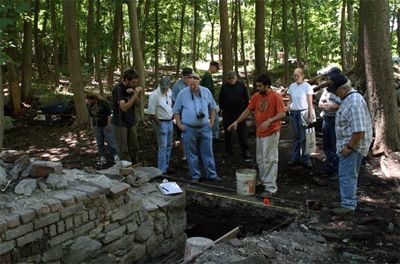Hello all! My name is Amy Bastion and I am a 4th year undergraduate at Michigan Technological University majoring in Anthropology with a focus on Archaeology. This season at West Point Foundry has been my first experience in the field, and is a step toward achieving a childhood goal of becoming an archaeologist.
After a much needed week-long break after the field school, our crew, which has decreased in size, has continued work in the field. Right away on Monday morning the crew, along with returning volunteer Terri Janson, began with a walk around the site. This allowed the new members to familiarize themselves with the Foundry and the 1817 molding shop, where we would be digging for the rest of the summer.
Throughout the rest of the week the crew worked on many different projects. Seth and Terri finished drawing soil profiles for the smoke-stack unit, eventually closing up that particular unit. Then Seth, Terri, and Dan moved to the curious molding shop doorway unit which contains the off-kilter brick wall feature. A valiant effort was made to find the bottom of the wall in hopes of determining an explanation for such a high quality brick wall built beneath the floor surface. But unfortunately, they reached the water table, or the ground water level, before the bottom of the brick.
Two new members of our crew, Cal Wacker and Janelle Schaeffer, continued excavation on the newest unit east of the 1817 molding shop entrance units, and uncovered the north doorway of the c. 1839 casting shop. They exposed the door sill, granite footings for the building, and also two iron pipes. Having these structures exposed validated the insurance maps used by project leader Dan, and also authenticated a photograph believed to be of the entrance.
Department of Social Science research associate Mike Deegan, incoming graduate student Yolanda Beltran, and I continued the nearly insurmountable task of excavating, photographing, and recording the very large cupola unit early in the week. After excavating further in the south end of the unit we discovered the granite and brick pillars which the cupola furnace would have stood had yet another base made of bluestone. Bluestone was chiefly quarried from New York and Pennsylvania and is celebrated for high density and the ability to withstand pressure. Alongside these bluestone bases was a thick layer of tan-yellow ashy sand, which we also moved through to find a very compact layer of sand. This layer of sand is not only very compact at the top, but is also particularly thick at about 30 cm deep. This compactness on the top leads our crew to believe it was some sort of fill, deposited very early around the legs of the cupola to elevate the floor and help protect the pillars, or it could have been deposited during the Cornell period to build up the floor to build atop it.
During this week we also had many visitors taking tours of the site, not only a group from the Watervliet Arsenal on Thursday (see photo), but we also held our 5th annual “Day at the Foundry” open house, on Saturday. The open house was a great success, approximately 185 people attended! By teaming with blacksmiths Dean Anderson and Amy Lahey of SuperSquare, a foundry in Newburgh, NY the public witnessed the process of mold-making and casting through the outstanding SuperSquare demonstration and our archaeology. We would sincerely like to thank everyone who attended the open house, our partners Scenic Hudson, and SuperSquare for all of their hard work!

Dan and Liz gave visitors from the Watervliet Arsenal a tour of the excavation units.



